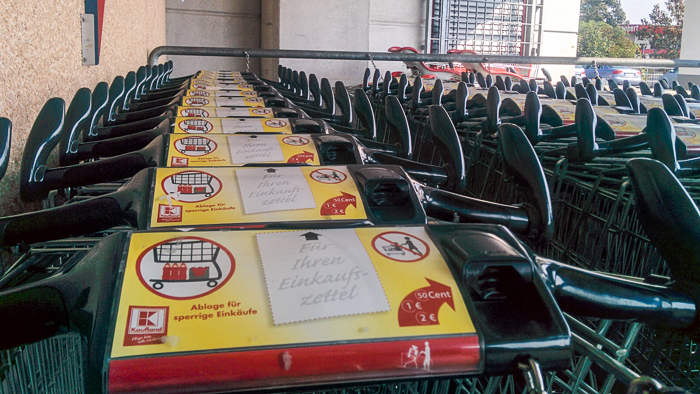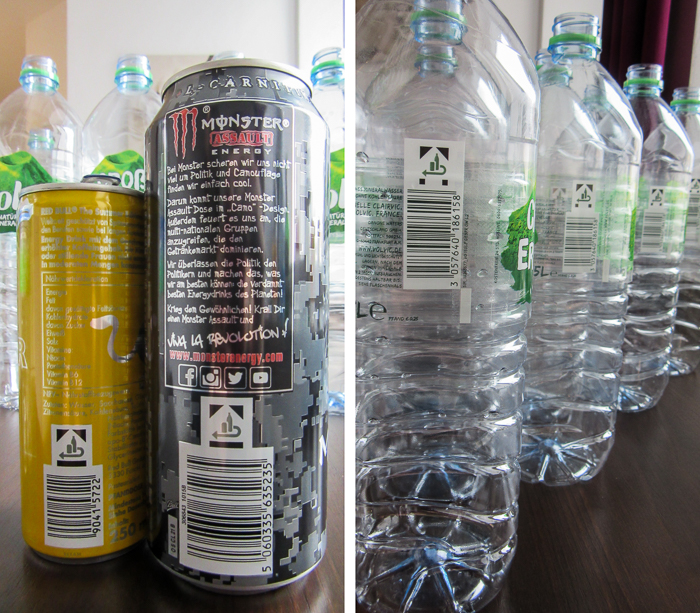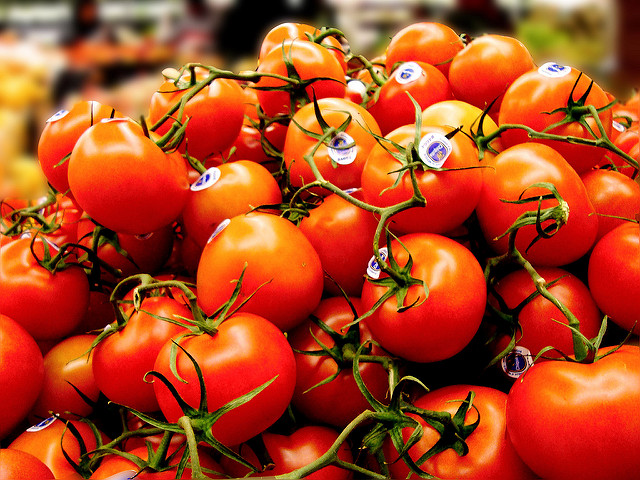Going grocery shopping in Germany has always been a stressful event for me. On my first visit to Kaufland, a few days after moving to Germany, I unintentionally made a cashier very angry because I didn’t weigh my bananas before checking out. Even after living in Germany for 13 months, it seemed like I always managed to do something wrong on each trip to the grocery store. So I’m sharing 20 ways that grocery shopping in Germany is different so that you can be more prepared for what to expect.





Grocery Shopping in Germany (Compared to the USA).
Going to the store.
1| When you go.

Grocery stores in our small Bavarian town were typically open from 7am – 8pm on Monday – Saturday and closed on Sundays. When I complained to some long-term expats about this, they informed me that just a few years prior the shops had closed at 6pm on weekdays and 2pm on Saturdays! I can’t imagine how much harder that would have been, as Mr. Meena and I struggled to make it to the store before 8pm.
2| Transportation.
We didn’t have a vehicle during our year in Germany, so we usually walked to the store. I’m not sure that I’ve ever walked to a grocery store in the USA – it’s usually not safe or feasible unless you’re in a large city. But in Germany it was very common for people to walk, bike, or take the bus to the grocery store instead of driving.
There were three grocery stores within walking distance; however, walking to the grocery store means you have to carry your purchases home. This is when I realized that groceries are quite heavy – especially bottled drinking water. Since we could only carry so much per trip, we went shopping often and purchased a minimal amount of items on each trip. Many Germans use roller carts to transport groceries home, but we never invested in one.
3| Preparation.
You’ll want to make sure you have a coin with you every time you need a shopping cart. Alternatively, there are plastic key chains you can purchase that will unlock the carts (although we were never able to figure out where you can buy them).

Many times I went to the store without a coin and had to resort to comically balancing items in my arms.
Preparing to go grocery shopping in Germany also means you’ll need to compile a list with German key words and ingredients – I quickly discovered that most of my recipes were impossible (or very difficult) to make in Germany because the ingredients were not available. Before heading to Germany you may want to practice making a few German meals so that you’re better prepared to cook with what items are available.
At the store.
4| Pfand return.
The first part of going grocery shopping in Germany is typically returning your beverage containers – almost every container you purchase will have the pfand symbol on it.

When you purchase a container you pay a pfand, or deposit, on it. These vary in worth, usually from five to 20 cents, and you get your deposit back when you return your empty containers to the store. This encourages people to recycle (and to annoy you at the train station by asking if they can have your empty bottles). It can be complicated, however, because you’ll need to remember which container came from which store as you can’t always return them to different places.
Soda bottles, water bottles, energy drink cans, beer bottles, etc. – you’ll get used to there being a pile of bottles somewhere in your living space. There are pfand machines at the entrance of most grocery stores (although sometimes they are inside the store) where you exchange your bottles for a receipt that you can use when paying for your groceries. We returned our bottles biweekly and usually had around two euros in pfand credits each time.
5| Price differences.
Grocery prices in Germany were cheaper overall compared to the USA. We could purchase fresh bread for 15 cents, a large package of bratwurst for 2.50 euros, and quality beer for 70 cents. If you eat what the Germans eat (sausage, bread, seasonal items) then you will definitely pay less than in America. However, when I reviewed our cost of living in Germany, I was surprised that we were only spending about $50 less on groceries each month. (This was partially because we purchased a lot of bottled water in Germany – something we almost never do in the USA – and we tended to seek out specialty foods that were less common in Germany and therefore more expensive.)
6| Produce selection.
I can purchase strawberries pretty much any time of year in the USA (although it’s not always financially wise to do so). This is not the case in Germany, as produce is typically only available when it is in season. Germans love local, organic produce, and many Germans prefer to buy their produce at the local farmers market instead of a chain store. However, the focus on organic, non-GMO, and low pesticide use farming policies in Germany results in produce that is very small in size, doesn’t taste very good, and is often full of bugs. I really missed the abundant produce selection from home.

7| Weighing and tagging your produce.
In some German grocery stores, such as Kaufland, you must weigh your produce before checking out. A good indicator that you need to weigh and tag your produce is the presence of scale machines with digital screens in the produce section (and people using them). If you forget to weigh your produce this causes a big problem at checkout because the cashiers don’t have built-in scales. And even if they do have a scale nearby, the cashiers tend to get angry if you haven’t tagged your produce or if you’ve tagged it incorrectly.
8| Nearly everything is smaller.
One of my favorite things about grocery shopping in the USA is that I can buy things in bulk. But I quickly learned that was not possible when grocery shopping in Germany. For example, look at the difference in size between peanut butter from Germany (left) and peanut butter from the USA (right).

Peanut butter can be hard to find in Germany and tends to be in small, expensive containers. However, Germans are hopelessly obsessed with Nutella, which you can buy in large containers. But in general, there aren’t very many large or bulk food items in your typical German grocery store.
9| Forget “American Items”.
No, seriously, forget them. After a few months of living in Germany, I went on an American food item scavenger hunt where I sampled and reviewed food items marked as American. Most of these foods were unsavory and downright confusing.
Even if you find an American specialty store, it’s unlikely the food will be exactly the same as in America. For example, in Germany soda is made with sugar instead of corn syrup. When we ordered some American soda from Amazon, it was actually the exact same soda made with sugar from the grocery store – with a higher price tag. So, unless you are willing to order a care package from home, stay away from the so called American food items in German grocery stores.
10| Out of stock items.
I distinctly remember being confused when Kaufland ran out of bananas on a Saturday afternoon; it was the first time I’d ever seen an empty banana section. This turned out to be a regular occurrence – with the bananas as well as other items. The only explanation I’ve come up is that the stores don’t want restock fresh items late in the week. Since they are all closed on Sundays, perhaps this is a way to keep items from spoiling in the meat, produce, and dairy departments.
In the USA, empty food shelves are usually only seen when there’s a big storm coming (or there is a hint of snow in the south).
